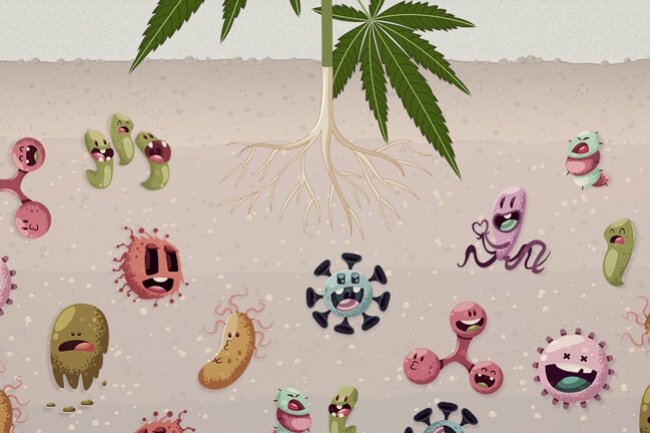
Soil Microbiology: A Primerby Vern Grubinger
|
| Although it may not be obvious, healthy soils are chock-full of living organisms. Some are visible to the naked eye, like earthworms, beetles, mites and springtails, but the majority of soil-dwellers are very, very small. They’re also very, very important to soil fertility.
Just a few grams of soil, less than a teaspoonful, may contain hundreds of millions to billions of microbes. Not only is the total number of microorganisms in fertile soil quite high, but together, they weigh a lot, too. Soil microbial biomass can range from several hundred to thousands of pounds per acre. By far, the most numerous microbes in soil are bacteria, which have just one cell. Also abundant are fungi, which produce long, slender strings of cells called filaments, or hyphae. The actinomycetes are in-between these two organisms. They are advanced bacteria that can form branches like fungi. It’s the actinomycetes that give soil its characteristic earthy smell. Fungi and actinomycetes are good at starting the decomposition of organic residues, working on materials that are tough to break down. Bacteria finish the job by eating the more digestible ingredients. Many other microbes can be found in smaller numbers in soil, including algae, cyanobacteria (often called blue-green algae), and protozoa (one-celled organisms that decompose organic materials and also consume bacteria). Nematodes are microscopic roundworms; some of these are beneficial and some are plant parasites. The soil zone located immediately around active roots is called the rhizosphere. This is an area of high microbial activity. Materials released from roots, called exudates, create a food-rich environment for the growth of microorganisms. Rhizosphere microorganisms in turn help plants by fixing nitrogen from the soil air, dissolving soil minerals and decomposing organic matter, all of which allow roots to obtain essential nutrients. Some microbes have a specialized role in the rhizosphere. Rhizobia bacteria associate with the roots of legumes to form nodules. This symbiotic relationship provides the bacteria with a source of carbon in exchange for making nitrogen available to the plant. Farmers are familiar with this process, and often encourage it by inoculating legume seeds with a commercial preparation of the Rhizobium species that is suited to the crop species they are planting. A special kind of fungus called mycorrhizae also associates with plants. By colonizing large areas of roots and reaching out into the soil, mycorrhizae aid in transfer of soil nutrients and water into the plant. This is especially important in situations where nutrient availability or moisture is limited. Microbes have a lot to do with maintaining good soil structure, which promotes infiltration and drainage of water, soil aeration, and vigorous root growth and exploration. Gummy substances produced by soil microbes (complex sugars and mucilages) help cement soil particles together into aggregates, which contribute to soil structure. This cement also makes aggregates less likely to crumble when exposed to water. Fungal hyphae further stabilize soil structure as their threadlike structures spread through the soil, surrounding particles and aggregates like a hairnet. The proportion of the different kinds of organisms present in your soil depends on conditions such as available moisture, aeration, organic matter levels and the type of plants present. Chemical conditions such as acidity and alkalinity will greatly affect soil organism populations. For example, fungi often prefer acidic soils, while actinomycetes thrive in more alkaline conditions. In order to encourage microbial activity on the farm, soil has to be managed to create a favorable environment for both crops and microbes. This can be done by timely and appropriate tillage that avoids compaction; irrigation and drainage practices that keep the soil moist but not waterlogged, liming to maintain a near-neutral pH, and frequent addition of organic (carbon-containing) residues to provide energy for the microbes. In general, the abundance of microbes in soil is proportional to the organic matter content. Soils that have large amounts of organic residues regularly added to them tend to support a larger microbial population. However, there is usually an explosion in microbial numbers after the addition of available carbon ‘fuel’, followed by a population crash as that fuel is consumed. Some of the fuel is incorporated into microbial cells and some is given off as carbon dioxide. Later, the microbial cells become food for other microbes and then they, too, are decomposed through microbial activities. So eventually, microbial activity returns to a low level unless more residues are added. The good news is that the microbes are always there, ready to leap into service when environmental conditions are suitable and there’s a source of energy. For more information on soil microbes, soil management and soil fertility, refer to “Building Soils for Better Crops,” by Fred Magdoff and Harold van Es, available from the Sustainable Agriculture Research and Education (SARE) Program at: www.sare.org/Learning-Center/Books/Building-Soils-for-Better-Crops-3rd-Edition. |
